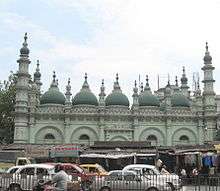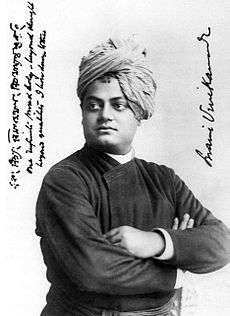West Bengal
| West Bengal পশ্চিমবঙ্গ | ||
|---|---|---|
| State | ||
| ||
 Location of West Bengal in India | ||
| Country | India | |
| Established | 26 January 1950 | |
| Capital | Kolkata | |
| Largest city / Largest metro | Kolkata | |
| Districts | 20 | |
| Government | ||
| • Body | Government of West Bengal | |
| • Governor | Keshari Nath Tripathi | |
| • Chief Minister | Mamata Banerjee (TMC) | |
| • Legislature | West Bengal Legislative Assembly (295* seats) | |
| • High Court | Calcutta High Court | |
| Area | ||
| • Total | 88,752 km2 (34,267 sq mi) | |
| Area rank | 14th | |
| Population (2011)[1] | ||
| • Total | 91,347,736 | |
| • Rank | 4th | |
| • Density | 1,000/km2 (2,700/sq mi) | |
| Time zone | IST (UTC+05:30) | |
| ISO 3166 code | IN-WB | |
| HDI |
| |
| HDI rank | 9th (2011)[2] | |
| Literacy | 77.08%[3] | |
| Official language | Bengali and English | |
| Website |
wb | |
| ^* 294 elected, 1 nominated | ||
West Bengal (/wɛst bɛŋˈɡɔːl/; Bengali pronunciation: [pɔʃtʃimbɔŋɡɔ]) is an Indian state, located in East India on the Bay of Bengal. It is India's fourth-most populous state, with over 91 million inhabitants. It has a total area of 34,267 sq mi (88,750 km2), making it similar in size to Serbia. A part of the ethno-linguistic Bengal region, it borders Bangladesh in the east and Nepal and Bhutan in the north. It also has borders with five Indian states, including Odisha, Jharkhand, Bihar, Sikkim and Assam.
The state capital is Kolkata (Calcutta), the third-largest city in India. The geography of West Bengal includes the Darjeeling Himalayan hill region in its extreme north, the Ganges delta, the Rarh region and the coastal Sundarbans. The main ethnic group are the Bengali people, with Bengali Hindus forming the demographic majority.
Ancient Bengal was the site of several major janapadas, including Vanga, Radha, Pundra and Suhma. In the 2nd century BC, the region was conquered by the emperor Ashoka. In the 4th century AD, it was absorbed into the Gupta Empire. From the 13th century onward, the region was ruled by several sultans, powerful Hindu states and Baro-Bhuyan landlords, until the beginning of British rule in the 18th century. The British East India Company cemented their hold on the region following the Battle of Plassey in 1757, and Calcutta served for many years as the capital of British India. The early and prolonged exposure to British administration resulted in expansion of Western education, culminating in development in science, institutional education, and social reforms of the region, including what became known as the Bengal Renaissance. A hotbed of the Indian independence movement through the early 20th century, Bengal was divided during India's independence in 1947 along religious lines into two separate entities: West Bengal—a state of India—and East Bengal—a part of the newly-created Pakistan—later becoming Bangladesh in 1971. Between 1977 and 2011, the state was administered by the world's longest elected Communist government.
A major agricultural producer, West Bengal is the sixth-largest contributor to India's net domestic product.[4] It is noted for its cultural activities and the presence of cultural and educational institutions; the state capital Kolkata is known as the "cultural capital of India". The state's cultural heritage, besides varied folk traditions, ranges from stalwarts in literature including Nobel-laureate Rabindranath Tagore to scores of musicians, film-makers and artists. West Bengal is also distinct from most other Indian states in its appreciation and practice of playing Association football besides cricket, the national favourite sport.[5][6][7]
Etymology
The origin of the name Bengal (known as Bangla and Bongo in Bengali language) is unknown. One theory suggests that the word derives from "Bang," a Dravidian tribe that settled the region around 1000 BC.[8] The word might have been derived from the ancient kingdom of Vanga (or Banga). Although some early Sanskrit literature mentions the name, the region's early history is obscure.
At the end of British Rule over the Indian subcontinent, the Bengal region was partitioned in 1947 along religious lines into east and west. The east came to be known as East Bengal and the west came to known as West Bengal, which continued as an Indian state. In 2011, the Government of West Bengal proposed a change in the official name of the state to Poschimbongo (Bengali: পশ্চিমবঙ্গ Pôshchimbônggô).[9][10] This is the native name of the state, literally meaning western Bengal in the native Bengali language. In August, 2016, West Bengal Legislative Assembly passed another resolution to change the name of West Bengal to "Bangal" in Hindi, "Bengal" in English and "Bangla" in Bengali. Despite the Trinamool Congress government’s strong efforts to forge a consensus on the name change resolution, the Indian National Congress, the Left Front and the Bharatiya Janata Party opposed the resolution, However it awaits the consent of the Indian Parliament for approval.[11]
History
Ancient and classical period
Stone Age tools dating back 20,000 years have been excavated in the state, showing human occupation 8,000 years earlier than scholars had thought based on prior evidence.[12] The region was a part of the Vanga Kingdom, according to the Indian epic Mahabharata.[13] Several Vedic realms were present in Bengal region, including Vanga, Rarh, Pundravardhana and the Suhma Kingdom.
One of the earliest foreign references to Bengal is a mention by the Ancient Greeks around 100 BC of a land named Gangaridai, which was located at the mouths of the Ganges.[14] Bengal had overseas trade relations with Suvarnabhumi (Burma, Lower Thailand, Lower Malay Peninsula, and the Sumatra).[15] According to the Sri Lankan chronicle Mahavamsa, Prince Vijaya, a Vanga Kingdom prince, conquered Lanka (modern-day Sri Lanka) and gave the name Sinhala Kingdom to the country.[16]
The kingdom of Magadha was formed in 7th century BCE, consisting of the regions now comprising Bihar and Bengal. It was one of the four main kingdoms of India at the time of the lives of Mahavira, founder of Jainism, and Gautama Buddha, founder of Buddhism. It consisted of several janapadas or kingdoms.[17] Under Ashoka, the Maurya Empire of Magadha in the 3rd century BCE extended over nearly all of South Asia, including Afghanistan and parts of Balochistan.[18] From the 3rd to the 6th centuries CE, the kingdom of Magadha served as the seat of the Gupta Empire.
Two kingdoms – Vanga or Samatata and Gauda – are mentioned in some texts to have appeared after the end of Gupta Empire, although details of their ruling time are uncertain.[19] The first recorded independent king of Bengal was Shashanka, who reigned in the early 7th century.[20] Shashanka is often recorded in Buddhist annals as an intolerant Hindu ruler who is noted for his persecution of the Buddhists. Shashanka murdered Rajyavardhana, the Buddhist King of Thanesar, and is noted for destroying the Bodhi tree at Bodhgaya, and replacing Buddha statues with Shiva lingams.[21] After a period of anarchy,[22]:36 the Pala dynasty ruled the region for four hundred years starting from the eighth century. It was followed by a shorter reign of the Hindu Sena dynasty.
Some areas of Bengal were invaded by Rajendra Chola I of the Chola dynasty between 1021 and 1023.[23] Islam made its first appearance in Bengal during the 12th century when Sufi missionaries arrived.[24] Later, occasional Muslim raiders reinforced the process of conversion by building mosques, madrasas and khanqahs. Between 1202 and 1206, Muhammad bin Bakhtiyar Khilji, a military commander from the Delhi Sultanate, overran Bihar and Bengal as far east as Rangpur, Bogra and the Brahmaputra River. Although he failed to bring Bengal under his control, the expedition defeated Lakshman Sen. His two sons moved to a place then called Vikramapur (present-day Munshiganj District), where their diminished dominion lasted until the late 13th century.
Medieval and early modern periods

Subsequent Muslim conquests helped spread Islam throughout the region.[25] Consequently, the region was ruled by dynasties of Bengal Sultanate and feudal lords under the Delhi Sultanate for the next few hundred years. While the large population of eastern and central Bengal became Muslim during this period, Hinduism remained the dominant religion in southern Bengal due to the strong influence of folk Hindu culture and Vaishnavism. Smaller Hindu states, landlords, and the Kingdom of Bhati also ruled in parts of Bengal. The Bengal Sultanate was interrupted for 20 years by an uprising by the Hindus under Raja Ganesha. In the sixteenth century, Mughal general Islam Khan conquered Bengal. However, administration by governors appointed by the court of the Mughal Empire gave way to semi-independence of the area under the Nawabs of Murshidabad, who nominally respected the sovereignty of the Mughals in Delhi. Several independent Hindu states were established in Bengal during the Mughal period, like those of Pratapaditya of Jessore District and Raja Sitaram Ray of Bardhaman. The Koch dynasty in northern Bengal flourished during the period of 16th and the 17th centuries; it weathered the Mughals and survived till the advent of the British colonial era.
Several European traders reached this area late in the fifteenth century. Their influence increased into the 18th century, when the British East India Company gained rights to collect revenue in Bengal subah (province) in 1765 as per the treaty between the East India company and Mughal emperor following the Battle of Buxar in 1764. Mir Qasim, the last independent Nawab, was defeated by the British.[26]
Colonial period


The Bengal Presidency was established in 1765; it later incorporated all British territories controlled north of the Central Provinces (now Madhya Pradesh), from the mouths of the Ganges and the Brahmaputra to the Himalayas and the Punjab. The Bengal famine of 1770 claimed millions of lives due to tax policies enacted by the British company.[27] Calcutta, the headquarters of the East India company, was named in 1772 as the capital of British-held territories in India. In 1793 East India company abolished local rule (Nizamat) and annexed the former Mughal province.
The Bengal Renaissance and Brahmo Samaj socio-cultural reform movements had great effects on the cultural and economic life of Bengal. The failed Indian rebellion of 1857 started near Calcutta and resulted in transfer of authority to the British Crown, administered by the Viceroy of India.[28] Between 1905 and 1911, an abortive attempt was made to divide the province of Bengal into two zones.[29] Bengal suffered from the Great Bengal famine in 1943, which claimed 3 million lives during World War II.[30]
Bengal played a major role in the Indian independence movement, in which revolutionary groups such as Anushilan Samiti and Jugantar were dominant. Armed attempts against the British Raj from Bengal reached a climax when Subhas Chandra Bose led the Indian National Army from Southeast Asia against the British.
Indian independence and afterwards
When India gained independence in 1947, Bengal was partitioned along religious lines. The western part went to Dominion of India (and was named West Bengal), while the eastern part went to Dominion of Pakistan as a province called East Bengal (later renamed as East Pakistan in 1956). The latter became independent Bangladesh in 1971.[31]
In 1950, the Princely State of Cooch Behar merged with West Bengal.[32] In 1955, the former French enclave of Chandannagar, which had passed into Indian control after 1950, was integrated into West Bengal; portions of Bihar were also subsequently merged with West Bengal. Both West and East Bengal suffered from large refugee influxes during and after the partition in 1947. Refugee resettlement and related issues continued to play a significant role in the politics and socio-economic condition of the state.[33]

During the 1970s and 1980s, severe power shortages, strikes and a violent Naxalite movement damaged much of the state's infrastructure, leading to a period of economic stagnation. The Bangladesh Liberation War of 1971 resulted in the influx of millions of refugees to West Bengal, causing significant strains on its infrastructure.[34] The 1974 smallpox epidemic killed thousands. West Bengal politics underwent a major change when the Left Front won the 1977 assembly election, defeating the incumbent Indian National Congress. The Left Front, led by Communist Party of India (Marxist), governed the state for the subsequent three decades.[35]
The state's economic recovery gathered momentum after economic liberalisations were introduced in the mid-1990s by the central government. This was aided by the advent of information technology and IT-enabled services. Since mid-2000s, armed activists conducted minor terrorist attacks in some parts of the state,[36][37] while clashes with the administration took place at several sensitive places over the issue of industrial land acquisition,[38][39] which became a crucial reason behind the defeat of ruling Left Front government in 2011 assembly election.[40]
Although the state's GDP has risen significantly since the 1990s, West Bengal has remained affected by political instability and bad governance.[41] The state continues to suffer from regular bandhs (strikes),[42][43] substandard healthcare services,[44][45] a lack of socio-economic development,[46] poor infrastructure,[47][48] political corruption, criminalisation of politics, unemployment, poor education facilities and civil violence.[49][50]
Geography and climate

West Bengal is on the eastern bottleneck of India, stretching from the Himalayas in the north, to the Bay of Bengal in the south. The state has a total area of 88,752 square kilometres (34,267 sq mi).[1] The Darjeeling Himalayan hill region in the northern extreme of the state belongs to the eastern Himalaya. This region contains Sandakfu (3,636 m or 11,929 ft)—the highest peak of the state.[51] The narrow Terai region separates this region from the North Bengal plains, which in turn transitions into the Ganges delta towards the south. The Rarh region intervenes between the Ganges delta in the east and the western plateau and high lands. A small coastal region is on the extreme south, while the Sundarbans mangrove forests form a geographical landmark at the Ganges delta.
The Ganges is the main river, which divides in West Bengal. One branch enters Bangladesh as the Padma or Pôdda, while the other flows through West Bengal as the Bhagirathi River and Hooghly River. The Farakka barrage over Ganges feeds the Hooghly branch of the river by a feeder canal, and its water flow management has been a source of lingering dispute between India and Bangladesh.[52] The Teesta, Torsa, Jaldhaka and Mahananda rivers are in the northern hilly region. The western plateau region has rivers such as the Damodar, Ajay and Kangsabati. The Ganges delta and the Sundarbans area have numerous rivers and creeks. Pollution of the Ganges from indiscriminate waste dumped into the river is a major problem.[53] Damodar, another tributary of the Ganges and once known as the "Sorrow of Bengal" (due to its frequent floods), has several dams under the Damodar Valley Project. At least nine districts in the state suffer from arsenic contamination of groundwater, and an estimated 8.7 million people drink water containing arsenic above the World Health Organisation recommended limit of 10 µg/L.[54]
West Bengal's climate varies from tropical savanna in the southern portions to humid subtropical in the north. The main seasons are summer, rainy season, a short autumn, and winter. While the summer in the delta region is noted for excessive humidity, the western highlands experience a dry summer like northern India, with the highest day temperature ranging from 38 °C (100 °F) to 45 °C (113 °F).[55] At nights, a cool southerly breeze carries moisture from the Bay of Bengal. In early summer brief squalls and thunderstorms known as Kalbaisakhi, or Nor'westers, often occur.[56] West Bengal receives the Bay of Bengal branch of the Indian ocean monsoon that moves in a northwest direction. Monsoons bring rain to the whole state from June to September. Heavy rainfall of above 250 cm is observed in the Darjeeling, Jalpaiguri and Cooch Behar district. During the arrival of the monsoons, low pressure in the Bay of Bengal region often leads to the occurrence of storms in the coastal areas. Winter (December–January) is mild over the plains with average minimum temperatures of 15 °C (59 °F).[55] A cold and dry northern wind blows in the winter, substantially lowering the humidity level. The Darjeeling Himalayan Hill region experiences a harsh winter, with occasional snowfall at places.
Flora and fauna
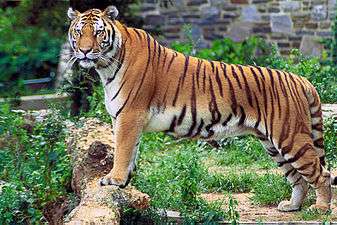
As of 2013, recorded forest area in the state is 16,805 km2 (6,488 sq mi) which is 18.93% of the state's geographical area, compared to the national average of 21.23%.[57] Reserves, protected and unclassed forests constitute 59.4%, 31.8% and 8.9%, respectively, of the forest area, as of 2009.[58] Part of the world's largest mangrove forest, the Sundarbans, is located in southern West Bengal.[59]
| State animal | Fishing cat[60] | |
| State bird | White-throated kingfisher | |
| State tree | Devil tree[60] | 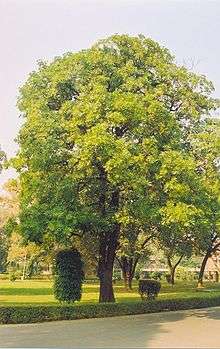 |
| State flower | Night-flowering jasmine[60] | |
From a phytogeographic viewpoint, the southern part of West Bengal can be divided into two regions: the Gangetic plain and the littoral mangrove forests of the Sundarbans.[61] The alluvial soil of the Gangetic plain, compounded with favourable rainfall, make this region especially fertile.[61] Much of the vegetation of the western part of the state shares floristic similarities with the plants of the Chota Nagpur plateau in the adjoining state of Jharkhand.[61] The predominant commercial tree species is Shorea robusta, commonly known as the Sal tree. The coastal region of Purba Medinipur exhibits coastal vegetation; the predominant tree is the Casuarina. A notable tree from the Sundarbans is the ubiquitous sundari (Heritiera fomes), from which the forest gets its name.[62]
The distribution of vegetation in northern West Bengal is dictated by elevation and precipitation. For example, the foothills of the Himalayas, the Dooars, are densely wooded with Sal and other tropical evergreen trees.[63] However, above an elevation of 1,000 metres (3,300 ft), the forest becomes predominantly subtropical. In Darjeeling, which is above 1,500 metres (4,900 ft), temperate-forest trees such as oaks, conifers, and rhododendrons predominate.[63]
West Bengal has 3.26% of its geographical area under protected areas comprising 15 wildlife sanctuaries and 5 national parks[58] — Sundarbans National Park, Buxa Tiger Reserve, Gorumara National Park, Neora Valley National Park and Singalila National Park. Extant wildlife include Indian rhinoceros, Indian elephant, deer, leopard, gaur, tiger, and crocodiles, as well as many bird species. Migratory birds come to the state during the winter.[64] The high-altitude forests of Singalila National Park shelter barking deer, red panda, chinkara, takin, serow, pangolin, minivet and kalij pheasants. The Sundarbans are noted for a reserve project conserving the endangered Bengal tiger, although the forest hosts many other endangered species, such as the Gangetic dolphin, river terrapin and estuarine crocodile.[65] The mangrove forest also acts as a natural fish nursery, supporting coastal fishes along the Bay of Bengal.[65] Recognising its special conservation value, Sundarban area has been declared as a Biosphere Reserve.[58]
Government and politics
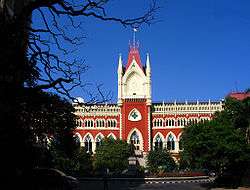
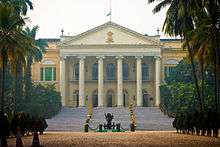
West Bengal is governed through a parliamentary system of representative democracy, a feature the state shares with other Indian states. Universal suffrage is granted to residents. There are two branches of government. The legislature, the West Bengal Legislative Assembly, consists of elected members and special office bearers such as the Speaker and Deputy Speaker, that are elected by the members. Assembly meetings are presided over by the Speaker or the Deputy Speaker in the Speaker's absence. The judiciary is composed of the Calcutta High Court and a system of lower courts. Executive authority is vested in the Council of Ministers headed by the Chief Minister, although the titular head of government is the Governor. The Governor is the head of state appointed by the President of India. The leader of the party or coalition with a majority in the Legislative Assembly is appointed as the Chief Minister by the Governor, and the Council of Ministers are appointed by the Governor on the advice of the Chief Minister. The Council of Ministers reports to the Legislative Assembly. The Assembly is unicameral with 295 Members of the Legislative Assembly, or MLAs,[66] including one nominated from the Anglo-Indian community. Terms of office run for 5 years, unless the Assembly is dissolved prior to the completion of the term. Auxiliary authorities known as panchayats, for which local body elections are regularly held, govern local affairs. The state contributes 42 seats to the Lok Sabha[67] and 16 seats to the Rajya Sabha of the Indian Parliament.[68]
The main players in the regional politics are the All India Trinamool Congress, the Indian National Congress, and the Left Front alliance (led by the Communist Party of India (Marxist) or CPI(M)). Following the West Bengal State Assembly Election in 2011, the All India Trinamool Congress and Indian National Congress coalition under Mamata Banerjee of the All India Trinamool Congress was elected to power (getting 225 seats in the legislature).[69] Prior to this, West Bengal was ruled by the Left Front for 34 years (1977–2011), making it the world's longest-running democratically elected communist government.[35]
Districts
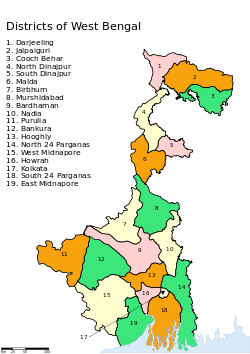
The following is a list of Twenty [70] (Jalpaiguri divided into two parts as Alipurduar & Japlaiguri in 2014) districts of West Bengal by rank in India.[71][72]
| Serial | Rank | District | Population | Growth rate | Sex ratio | Literacy | Density per square Kilometer |
|---|---|---|---|---|---|---|---|
| 1 | 2 | North 24 Parganas | 10,082,852 | 12.86 | 949 | 84.95 | 2463 |
| 2 | 6 | South 24 Parganas | 8,153,176 | 18.05 | 949 | 78.57 | 819 |
| 3 | 7 | Bardhaman | 7,723,663 | 12.01 | 943 | 77.15 | 1100 |
| 4 | 9 | Murshidabad | 7,102,430 | 21.07 | 957 | 67.53 | 1334 |
| 5 | 14 | West Midnapore | 5,943,300 | 14.44 | 960 | 79.04 | 636 |
| 6 | 16 | Hooghly | 5,520,389 | 9.49 | 958 | 82.55 | 1753 |
| 7 | 18 | Nadia | 5,168,488 | 12.24 | 947 | 75.58 | 1316 |
| 8 | 20 | East Midnapore | 5,094,238 | 15.32 | 936 | 87.66 | 1076 |
| 9 | 23 | Howrah | 4,841,638 | 13.31 | 935 | 83.85 | 3300 |
| 10 | 35 | Kolkata | 4,486,679 | −1.88 | 899 | 87.14 | 24252 |
| 11 | 58 | Maldah | 3,997,970 | 21.50 | 939 | 62.71 | 1071 |
| 12 | 66 | Jalpaiguri | 2,172,846 | 13.77 | 954 | 73.79 | 621 |
| 13 | Alipurduar | 1,700,000 | 400 | ||||
| 14 | 80 | Bankura | 3,596,292 | 12.64 | 954 | 70.95 | 523 |
| 15 | 84 | Birbhum | 3,502,387 | 16.15 | 956 | 70.90 | 771 |
| 16 | 124 | North Dinajpur | 3,000,849 | 22.90 | 936 | 60.13 | 956 |
| 17 | 129 | Purulia | 2,927,965 | 15.43 | 955 | 65.38 | 468 |
| 18 | 136 | Cooch Behar | 2,822,780 | 13.86 | 942 | 75.49 | 833 |
| 19 | 257 | Darjeeling | 1,842,034 | 14.47 | 971 | 79.92 | 585 |
| 20 | 295 | Dakshin Dinajpur | 1,670,931 | 11.16 | 954 | 73.86 | 753 |
Each district is governed by a district collector or district magistrate, appointed either by the Indian Administrative Service or the West Bengal Civil Service.[73] Each district is subdivided into Sub-Divisions, governed by a sub-divisional magistrate, and again into Blocks. Blocks consists of panchayats (village councils) and town municipalities.[72]
The capital and largest city of the state is Kolkata – the third-largest urban agglomeration[74] and the seventh-largest city[75] in India. Asansol is the second largest city & urban agglomeration in West Bengal after Kolkata.[74] Siliguri is an economically important city, strategically located in the northeastern Siliguri Corridor (Chicken's Neck) of India. Other cities and towns in West Bengal with 2011 populations over 250,000 are Durgapur, Bardhaman, English Bazar, Baharampur, Habra, Kharagpur and Shantipur.
Economy
| Net State Domestic Product at Factor Cost at Current Prices (2004–05 Base)[4] (figures in crores of Indian rupees) | |
| Year | Net State Domestic Product |
|---|---|
| 2004–2005 | 190,073 |
| 2005–2006 | 209,642 |
| 2006–2007 | 238,625 |
| 2007–2008 | 272,166 |
| 2008–2009 | 309,799 |
| 2009–2010 | 366,318 |

As of 2015, West Bengal has the fifth highest GSDP in India. GSDP at current prices (base 2004–05) has increased from 208,656 crores in 2004–05 to 800,868 crores in 2014–15.[76] GSDP Percent growth at current prices has varied from a low of 10.3% in 2010–11 to a high of 17.11% in 2013–14. The growth rate was 13.35% in 2014–15.[77] The state’s per capita income has lagged the all India average for over two decades. As of 2014–15 per capita NSDP at current prices was Rs 78,903.[77] Per capita NSDP growth rate at current prices has varied from 9.4% in 2010–11 to a high of 16.15% in 2013–14. The growth rate was 12.62% in 2014–15[78]

In 2015–16, percentage share of Gross Value Addded (GVA) at factor cost by Economic Activity at constant price (base year 2011–12) was Agriculture-Forestry &Fishery – 14.84%, Industry 18.51% and Services 66.65%. It has been observed that there has been a slow but steady decline in the percentage share of industry and agriculture over the years.[79] Agriculture is the leading occupation in West Bengal. Rice is the state's principal food crop. Rice, potato, jute, sugarcane and wheat are the top five crops of the state.[80]:14 Tea is produced commercially in northern districts; the region is well known for Darjeeling and other high quality teas.[80]:14 State industries are localised in the Kolkata region, the mineral-rich western highlands, and Haldia port region.[81] The Durgapur–Asansol colliery belt is home to a number of major steel plants.[81] Manufacturing industries playing an important economic role are engineering products, electronics, electrical equipment, cables, steel, leather, textiles, jewellery, frigates, automobiles, railway coaches, and wagons. The Durgapur centre has established a number of industries in the areas of tea, sugar, chemicals and fertilisers. Natural resources like tea and jute in and nearby parts has made West Bengal a major centre for the jute and tea industries.
Years after independence, West Bengal was still dependent on the central government for meeting its demands for food; food production remained stagnant and the Indian green revolution bypassed the state. However, there has been a significant spurt in food production since the 1980s, and the state now has a surplus of grains.[82] The state's share of total industrial output in India was 9.8% in 1980–81, declining to 5% by 1997–98. However, the service sector has grown at a rate higher than the national rate.[82]
In the period 2004–2005 to 2009–2010, the average gross state domestic product (GSDP) growth rate was 13.9% (calculated in Indian rupee term), lower than 15.5%, the average for all states of the country.[80]:4 The state's total financial debt stood at ₹1,918,350 million (US$29 billion) as of 2011.[83]
The state has promoted foreign direct investment, which has mostly come in the software and electronics fields; Kolkata is becoming a major hub for the Information technology (IT) industry. Rapid industrialisation process has given rise to debate over land acquisition for industry in this agrarian state.[84] NASSCOM–Gartner ranks West Bengal power infrastructure the best in the country.[85] Notably, many corporate companies are now headquartered in Kolkata include ITC Limited, India Government Mint, Kolkata, Haldia Petrochemicals, Exide Industries, Hindustan Motors, Bata India, Birla Corporation, CESC Limited, Coal India Limited, Damodar Valley Corporation, PwC India, Peerless Group, Berger Paints India, Emami, ABP Group, Bandhan Bank, United Bank of India, UCO Bank and Allahabad Bank. In 2010s, events such as adoption of "Look East" policy by the government of India, opening of the Nathu La Pass in Sikkim as a border trade-route with China and immense interest in the South East Asian countries to enter the Indian market and invest have put Kolkata in an advantageous position for development in future, particularly with likes of Myanmar, where India needs oil from military regime.[86][87]
Transport
.jpg)
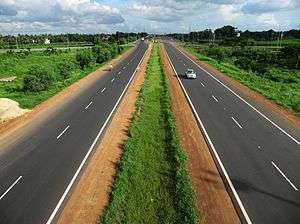
As of 2011, the total length of surface road in West Bengal is over 92,023 km (57,180 mi);[80]:18 national highways comprise 2,578 km (1,602 mi)[88] and state highways 2,393 km (1,487 mi).[80]:18 As of 2006, the road density of the state is 103.69 km per 100 km2 (166.92 mi per 100 sq mi), higher than the national average of 74.7 km per 100 km2 (120 mi per 100 sq mi).[89]
As of 2011, the total railway route length is around 4,481 km (2,784 mi).[80]:20 Kolkata is the headquarters of three zones of the Indian Railways — Eastern Railway and South Eastern Railway and the Kolkata Metro which is the newly formed 17th Zone of the Indian Railways.[90][91] The Northeast Frontier Railway (NFR) plies in the northern parts of the state. The Kolkata metro is the country's first underground railway.[92] The Darjeeling Himalayan Railway, part of NFR, is a UNESCO World Heritage Site.[93]
Netaji Subhas Chandra Bose International Airport at Dum Dum, Kolkata, is the state's biggest airport. Bagdogra Airport near Siliguri is a customs airport that has international services to Bhutan and Thailand besides regular domestic services. Kazi Nazrul Islam Airport, India's first private sector airport, serves the twin cities of Asansol-Durgapur at Andal, Bardhaman.[94][95]
Kolkata is a major river-port in eastern India. The Kolkata Port Trust manages the Kolkata and the Haldia docks.[96] There is passenger service to Port Blair on the Andaman and Nicobar Islands and cargo ship service to ports in India and abroad, operated by the Shipping Corporation of India. Ferry is a principal mode of transport in the southern part of the state, especially in the Sundarbans area. Kolkata is the only city in India to have trams as a mode of transport and these are operated by the Calcutta Tramways Company.[97]
Several government-owned organisations operate bus services in the state, including the Calcutta State Transport Corporation, the North Bengal State Transport Corporation, the South Bengal State Transport Corporation, the West Bengal Surface Transport Corporation, and the Calcutta Tramways Company. There are also private bus companies. The railway system is a nationalised service without any private investment. Hired forms of transport include metered taxis and auto rickshaws which often ply specific routes in cities. In most of the state, cycle rickshaws, and in Kolkata, hand-pulled rickshaws, electric rickshaw are used for short-distance travel.
Demographics
| Population Growth | |||
|---|---|---|---|
| Census | Pop. | %± | |
| 1951 | 26,300,000 | — | |
| 1961 | 34,926,000 | 32.8% | |
| 1971 | 44,312,000 | 26.9% | |
| 1981 | 54,581,000 | 23.2% | |
| 1991 | 68,078,000 | 24.7% | |
| 2001 | 80,176,000 | 17.8% | |
| 2011 | 91,348,000 | 13.9% | |
| Source:Census of India[98] | |||
According to the provisional results of the 2011 national census, West Bengal is the fourth most populous state in India with a population of 91,347,736 (7.55% of India's population).[1] Bengalis, consisting of Bengali Hindus, Bengali Muslims, Bengali Christians and a few Bengali Buddhists comprise the majority of the population.[99] The Marwari and Bihari non-Bengali minorities are scattered throughout the state; various indigenous ethnic Buddhist communities such as the Sherpas, the Bhutias, the Lepchas, the Tamangs, the Yolmos and the ethnic Tibetans can be found in the Darjeeling Himalayan hill region. The Darjeeling district also has a large number of Nepali immigrant population, making Nepali a widely spoken language in this region. West Bengal is home to indigenous tribal Adivasis such as Santhal, Munda, Oraon, Bhumij, Lodha, Kol and Toto tribe. There are a small number of ethnic minorities primarily in the state capital, including Chinese, Tamils, Maharashtrians, Odias, Assamese, Malayalis, Gujaratis, Anglo-Indians, Armenians, Jews, Punjabis, and Parsis.[100] India's sole Chinatown is in eastern Kolkata.[101]
The official language is Bengali and English.[102] Nepali language also has an official status in the three subdivisions of Darjeeling district.[102] As of 2001, in decreasing order of number of speakers, the languages of the state are: Bengali, Hindi, Santali, Urdu and Nepali.[102]
West Bengal is religiously diverse, with region wise cultural and religious specificities. Although Hindus are the predominant community, the state has a large minority Muslim population. Christians, Buddhists and others form a minuscule part of the population. As of 2011, Hinduism is the largest religion followed by 70.53% of the total population,[103] while Muslims comprise 27.01% of the total population, being the second-largest community as also the largest minority group.[104] Sikhism, Christianity, Buddhism and other religions make up the remainder.[105] Buddhism remains a prominent religion in the Himalayan region of the Darjeeling hills, and almost the entirety of West Bengal's Buddhist population are from this region.
The state contributes 7.8% of India's population.[106] Hindu population is 6,43,85,546 in West Bengal while Muslim population is 2,46,54,825 as per 2011 census.[107] The state's 2001–2011 decennial growth rate was 13.93%,[1] lower than 1991–2001 growth rate of 17.8%,[1] and also lower than the national rate of 17.64%.[108] The gender ratio is 947 females per 1000 males.[108] As of 2011, West Bengal has a population density of 1,029 inhabitants per square kilometre (2,670/sq mi) making it the second-most densely populated state in India, after Bihar.[108]
The literacy rate is 77.08%, higher than the national rate of 74.04%.[110] Data of 1995–1999 showed the life expectancy in the state was 63.4 years, higher than the national value of 61.7 years.[111] About 72% of people live in rural areas. The proportion of people living below the poverty line in 1999–2000 was 31.9%.[82] Scheduled Castes and Tribes form 28.6% and 5.8% of the population respectively in rural areas, and 19.9% and 1.5% respectively in urban areas.[82] A study conducted in three districts of West Bengal found that accessing private health services to treat illness had a catastrophic impact on households. This indicates the value of public provision of health services to mitigate against poverty and the impact of illness on poor households.[112]
The latest Sample Registration System (SRS) statistical report show that West Bengal has the lowest fertility rate amongst all the other Indian states. West Bengal's total fertility rate was 1.6, way below Bihar's 3.4, which is the highest in the entire country. Bengal’s TFR of (1.6) roughly equals to that of Canada.[113]
Culture
Literature
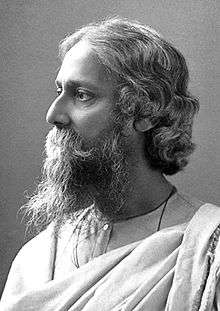
The Bengali language boasts a rich literary heritage, shared with neighbouring Bangladesh. West Bengal has a long tradition in folk literature, evidenced by the Charyapada, Mangalkavya, Shreekrishna Kirtana, Thakurmar Jhuli, and stories related to Gopal Bhar. In the nineteenth and twentieth century, Bengali literature was modernised in the works of authors such as Bankim Chandra Chattopadhyay, Michael Madhusudan Dutt, Rabindranath Tagore, Kazi Nazrul Islam, Sharat Chandra Chattopadhyay, Jibanananda Das and Manik Bandyopadhyay. In modern times Jibanananda Das, Bibhutibhushan Bandopadhyay, Tarashankar Bandopadhyay, Manik Bandopadhyay, Ashapurna Devi, Shirshendu Mukhopadhyay, Saradindu Bandopadhyay, Buddhadeb Guha, Mahashweta Devi, Samaresh Majumdar, Mohit Chattopadhyay, Sanjeev Chattopadhyay, Shakti Chattopadhyay, Buddhadeb Basu, Joy Goswami and Sunil Gangopadhyay among others are well known.
Music and dance
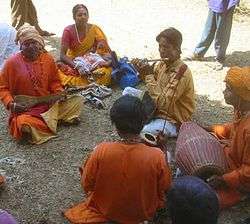
The Baul tradition is a unique heritage of Bengali folk music, which has also been influenced by regional music traditions.[116] Other folk music forms include Gombhira and Bhawaiya. Folk music in West Bengal is often accompanied by the ektara, a one-stringed instrument. West Bengal also has a heritage in North Indian classical music. "Rabindrasangeet", songs composed and set into tune by Rabindranath Tagore and "Nazrul geeti" (by Kazi Nazrul Islam) are popular. Also prominent are other musical forms like Dwijendralal, Atulprasad and Rajanikanta's songs, and "adhunik" or modern music from films and other composers. Shyama Sangeet or songs in praise of Hindu goddess Kali are tremendously popular, especially during Kali Puja, a major festival of Bengal.
Bengali dance forms draw from folk traditions, especially those of the tribal groups, as well as the broader Indian dance traditions. Chhau dance of Purulia is a rare form of mask dance.
Films
Mainstream Hindi films are popular in Bengal, and the state is home to a Tollywood. Tollygunj in Kolkata is the location of numerous Bengali movie studios, and the name "Tollywood" (similar to Hollywood and Bollywood) is derived from that name. The Bengali film industry is well known for its art films, and has produced acclaimed directors like Satyajit Ray, Mrinal Sen, Tapan Sinha and Ritwik Ghatak. Prominent contemporary directors include veterans like Buddhadev Dasgupta, Tarun Majumdar, Goutam Ghose, Aparna Sen, Rituparno Ghosh and a newer pool of directors like Kaushik Ganguly and Srijit Mukherji.
Fine arts

There are significant examples of fine arts in Bengal from earlier times such as terracotta art of Hindu temples, Kalighat paintings etc. Bengal has been the harbinger of modernism in fine arts. Abanindranath Tagore, called the father of Modern Indian Art had started the Bengal School of Art which was to create styles of art outside the European realist tradition which was taught in art colleges under the colonial administration of the British Government. The movement had many adherents like Gaganendranath Tagore, Ramkinkar Baij, Jamini Roy and Rabindranath Tagore. After Indian Independence, important groups like the Calcutta Group and the Society of Contemporary Artists were formed in Bengal which dominated the art scene in India.
Reformist heritage
The capital, Kolkata, was the workplace of several social reformers, like Raja Ram Mohan Roy, Iswar Chandra Vidyasagar, and Swami Vivekananda. These social reforms have eventually led to a cultural atmosphere where practices like sati, dowry, and caste-based discrimination or untouchability, the evils that crept into the Hindu society, were abolished. The region was also home to several religious teachers, such as Chaitanya, Ramakrishna, Prabhupada and Paramahansa Yogananda.
Cuisine

Rice and fish are traditional favourite foods, leading to a saying in Bengali, machhe bhate bangali, that translates as "fish and rice make a Bengali".[117] Bengal's vast repertoire of fish-based dishes includes hilsa preparations, a favourite among Bengalis. There are numerous ways of cooking fish depending on the texture, size, fat content and the bones. Most of the people also consume egg, chicken, mutton, shrimps etc. Sweets occupy an important place in the diet of Bengalis and at their social ceremonies. It is an ancient custom among both Bengali Hindus and Bengali Muslims to distribute sweets during festivities. The confectionery industry has flourished because of its close association with social and religious ceremonies. Competition and changing tastes have helped to create many new sweets. Bengalis make distinctive sweetmeats from milk products, including Rôshogolla, Chômchôm, Kalojam and several kinds of sondesh. Pitha, a kind of sweet cake, bread or dimsum are specialties of winter season. Sweets like narkol-naru, til-naru, moa, payesh etc. are prepared during the festival of Lakshmi puja. Popular street food includes Aloor Chop, Beguni, Kati roll, biryani and phuchka.[118][119]

The variety of fruits and vegetables that Bengal has to offer is incredible. A host of gourds, roots and tubers, leafy greens, succulent stalks, lemons and limes, green and purple eggplants, red onions, plantain, broad beans, okra, banana tree stems and flowers, green jackfruit and red pumpkins are to be found in the markets or anaj bazaar as popularly called. Panta bhat (rice soaked overnight in water)with onion & green chili is a traditional dish consumed in rural areas. Common spices found in a Bengali kitchen are cumin, ajmoda (radhuni), bay leaf, mustard, ginger, green chillies, turmeric, etc. People of erstwhile East Bengal use a lot of ajmoda, coriander leaves, tamarind, coconut and mustard in their cooking; while those aboriginally from West Bengal use a lot of sugar, garam masala and red chilli powder. Vegetarian dishes are mostly without onion and garlic.
Costumes
Bengali women commonly wear the sari, often distinctly designed according to local cultural customs. In urban areas, many women and men wear western attire. Among men, western dressing has greater acceptance. Men also wear traditional costumes such as the panjabi with dhuti, often on cultural occasions, while women prefer to wear salwar kameez.
Weaving
West Bengal has a rich heritage of handloom weaving, and produces some of the finest varieties of cotton and silk sarees in the country. From an economic standpoint, handlooms come second only to agriculture in providing livelihood to the rural population of the state. Every district has weaving ‘clusters’, which are home to artisan communities, each specialising in specific varieties of handloom weaving. Famous handloom sarees woven in the state include tant, jamdani, garad, korial, baluchari, tussar and muslin.[120]
Festivals


Durga Puja in September–October is the most popular and most widely celebrated festival in West Bengal.[121] This five-day-long colourful Hindu festival witnesses intense celebration across the state. Pandals are erected in various cities, towns and villages throughout West Bengal. The whole city of Kolkata undergoes a transformation during Durga Puja, as it is decked up in lighting decorations and thousands of colourful pandals are set up where effigies of goddess Durga and her four children are worshipped and displayed. The idols of the goddess as brought in from Kumortuli, where idol-makers work round the year fashioning the clay-models of the goddess. Since independence in 1947, Durga Puja has slowly changed into more of a glamourous carnival than a religious festival, where people across diverse religious and ethnic spectrum partake in the festivity.[122] On Vijayadashami, the last day of the festival, the effigies are paraded through the streets with riotous pageantry before being dumped into the rivers.[123]
Rath Yatra is a Hindu festival which celebrates Jagannath, a form of Krishna. It is celebrated with much fanfare both in Kolkata as well as in rural Bengal. Images of Jagannath are set upon a chariot and pulled through the streets.
Poila Baishakh, Dolyatra or Holi, Poush Parbon, Kali Puja, Saraswati Puja, Diwali, Lakshmi Puja, Janmashtami, Jagaddhatri Puja, Vishwakarma Puja, Bhai Phonta, Rakhi Bandhan, Kalpataru Day, Shivratri, Ganesh Chathurthi, Maghotsav, Kartik Puja, Akshay Tritiya, Raas Yatra, Guru Purnima, Annapurna Puja, Charak Puja, Gajan, Buddha Purnima, Christmas, Eid ul-Fitr, Eid ul-Adha and Muharram are other major festivals of Bengal. Rabindra Jayanti, Kolkata Book Fair, Kolkata Film Festival and Nazrul Jayanti are important socio-cultural events.
Eid al-Fitr is the most important festival of Muslims in Bengal. Muslims celebrate the end of Ramadan with prayers, alms-giving, shopping, gift-giving and feasting.
Christmas, called Bôŗodin (Great day) is perhaps the next major festival celebrated in Kolkata, after Durga Puja. Just like Durga Puja, Christmas in Kolkata is an occasion in which all communities and people across religions take part. The state tourism department organises the gala Christmas Festival every year in Park Street.[124] The whole of Park Street is decked up in colourful lights, various food stalls are set up selling cakes, chocolates, Chinese cuisines, momo and various other items. Musical groups from Darjeeling and other states of North East India are invited by the state to perform choir recitals, carols and jazz numbers.[125]Buddha Purnima, which marks the birth of Gautama Buddha, is one of the most important Hindu/Buddhist festivals and is celebrated with much gusto in the Darjeeling hills. On this day, processions are taken out of each of the various Buddhist monasteries or gumpas, and these congregate at the Mall, Chowrasta. The Lamas chant mantras and sound their bugles, and students as well as people from all communities carry the holy books or pustaks on their heads. Besides Buddha Purnima, Dashain or Dusshera, Holi, Diwali, Losar, Namsoong or the Lepcha New Year and Losoong are the other major festivals of the Darjeeling Himalayan region.
Poush mela is a popular festival of Shantiniketan in winter. Folk music, Baul songs, dance and theatre radiate across the town during this festival.
Ganga Sagar mela coincides with the Makar Sankranti and hundreds of thousands of Hindu pilgrims converge where river Ganges meets the sea to bathe en masse during this fervent festival.
Education
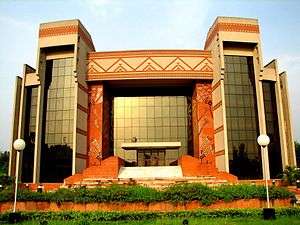
West Bengal schools are run by the state government or by private organisations, including religious institutions. Instruction is mainly in English or Bengali, though Urdu is also used, especially in Central Kolkata. The secondary schools are affiliated with the Council for the Indian School Certificate Examinations (CISCE), the Central Board for Secondary Education (CBSE), the National Institute of Open School (NIOS) or the West Bengal Board of Secondary Education.[126]
Under the 10+2+3 plan, after completing secondary school, students typically enroll for two years in a junior college, also known as pre-university, or in schools with a higher secondary facility affiliated with the West Bengal Council of Higher Secondary Education or any central board. Students choose from one of three streams: liberal arts, commerce or science. Upon completing the required coursework, students may enroll in general or professional degree programs.

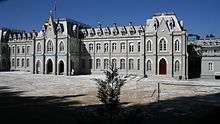
Some of the renowned schools in the city are La Martiniere Calcutta, St. Xavier's Collegiate School, and Loreto House - which consistently rank amongst the best schools in the country.[127] Many of the schools in Kolkata and Darjeeling are renowned colonial-era establishments and boast of fantastic neo-classical architecture. The famous schools of Darjeeling include St. Paul's, St. Joseph's North Point, Goethals Memorial School and Dow Hill in Kurseong.
West Bengal has 18 universities.[128][129] Kolkata has played a pioneering role in the development of the modern education system in India. It is the gateway to the revolution of European education. Sir William Jones established the Asiatic Society in 1794 for promoting oriental studies. People like Ram Mohan Roy, David Hare, Ishwar Chandra Vidyasagar, Alexander Duff and William Carey played leading roles in the setting up of modern schools and colleges in the city.
The University of Calcutta, the oldest public university in India, has 136 affiliated colleges. The Fort William College was established in 1810. The Hindu College was established in 1817. The Scottish Church College, which is the oldest Christian liberal arts college in South Asia, started its journey in 1830. In 1855 the Hindu College was renamed as the Presidency College.[130] In 2010, it was granted university status by the state government and was renamed Presidency University. The Kazi Nazrul University was established in 2012. The University of Calcutta and Jadavpur University are prestigious technical universities.[131] Visva-Bharati University at Santiniketan is a central university and an institution of national importance.[132]
The state has several higher education institutes of national importance including Indian Institute of Foreign Trade, Indian Institute of Management Calcutta (the first IIM), Indian Institute of Science Education and Research, Kolkata, Indian Statistical Institute, Indian Institute of Technology Kharagpur (the first IIT), Indian Institute of Engineering Science and Technology, Shibpur (the first IIEST), National Institute of Technology, Durgapur and West Bengal National University of Juridical Sciences. After 2003 the state govt supported the creation of West Bengal University of Technology, West Bengal State University and Gour Banga University.
Jadavpur University (Focus Area - Mobile Computing and Communication and Nano-Science) and University of Calcutta (Modern Biology) are among two of the fifteen universities selected under the scheme - University with Potential for Excellence. University of Calcutta (Focus Area - Electro-Physiological and Neuro-imaging studies including mathematical modeling) has also been selected under the scheme Centre with Potential for Excellence in Particular Area.[133]
Besides these, the state has Kalyani University, The University of Burdwan, Vidyasagar University and North Bengal University — all well-established and nationally renowned — to cover the education needs at the district level and an Indian Institute of Science Education and Research, Kolkata. Apart from this there is a private university run by Ramakrishna mission named Ramakrishna Mission Vivekananda University at Belur Math.
There are a number of research institutes in Kolkata. The Indian Association for the Cultivation of Science is the first research institute in Asia. C. V. Raman got the Nobel Prize for his discovery (Raman Effect) done in IACS. The Bose Institute, Saha Institute of Nuclear Physics, S.N. Bose National Centre for Basic Sciences, Indian Institute of Chemical Biology, Central Glass and Ceramic Research Institute, National Institute of Biomedical Genomics (NIBMG), Kalyani and the Variable Energy Cyclotron Centre are most prominent.
Notable scholars who were born, worked or studied in the geographic area of the state include physicists Satyendra Nath Bose, Meghnad Saha,[134] and Jagadish Chandra Bose;[135] chemist Prafulla Chandra Roy;[134] statisticians Prasanta Chandra Mahalanobis and Anil Kumar Gain;[134] physician Upendranath Brahmachari;[134] educator Ashutosh Mukherjee;[136] and Nobel laureates Rabindranath Tagore,[137] C. V. Raman,[135] and Amartya Sen.[138]
Media
West Bengal had 505 published newspapers in 2005,[139] of which 389 were in Bengali.[139] Ananda Bazar Patrika, published from Kolkata with 1,277,801 daily copies, has the largest circulation for a single-edition, regional language newspaper in India.[139] Other major Bengali newspapers are Bartaman, Sangbad Pratidin, Aajkaal, Jago Bangla, Uttarbanga Sambad and Ganashakti. Major English language newspapers which are published and sold in large numbers are The Telegraph, The Times of India, Hindustan Times, The Hindu, The Statesman, The Indian Express and Asian Age. Some prominent financial dailies like The Economic Times, Financial Express, Business Line and Business Standard are widely circulated. Vernacular newspapers such as those in Hindi, Nepali Gujarati, Odia, Urdu and Punjabi are also read by a select readership.
Doordarshan is the state-owned television broadcaster. Multi system operators provide a mix of Bengali, Nepali, Hindi, English and international channels via cable. Bengali 24-hour television news channels include ABP Ananda, Tara Newz, Kolkata TV, News Time, 24 Ghanta, Mahuaa Khobor, CTVN Plus, Channel 10 and R Plus.[140][141] All India Radio is a public radio station.[141] Private FM stations are available only in cities like Kolkata, Siliguri and Asansol.[141] Vodafone, Airtel, BSNL, Reliance Communications, Uninor, Aircel, MTS India, Idea Cellular and Tata DoCoMo are available cellular phone operators. Broadband internet is available in select towns and cities and is provided by the state-run BSNL and by other private companies. Dial-up access is provided throughout the state by BSNL and other providers.
Sports
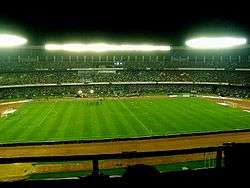
Cricket and soccer are popular sports in the state. West Bengal, unlike most other states of India, is noted for its passion and patronage of football.[5][6][7] Kolkata is one of the major centres for football in India[142] and houses top national clubs such as East Bengal, Mohun Bagan and Mohammedan Sporting Club.[143]
West Bengal has several large stadiums—The Eden Gardens is one of only two 100,000-seat cricket amphitheaters in the world, although renovations will reduce this figure.[144] Kolkata Knight Riders, East Zone and Bengal play there, and the 1987 World Cup final was there although in 2011 World Cup. Calcutta Cricket and Football Club is the second-oldest cricket club in the world.[145] Notable sports persons from West Bengal include former Indian national cricket captain Sourav Ganguly, Pankaj Roy Olympic tennis bronze medallist Leander Paes, and chess grand master Dibyendu Barua.[146]

See also
- Outline of West Bengal
- India
- Outline of India
- Index of India-related articles
- Bibliography of India
-
 India – Wikipedia book
India – Wikipedia book - Partition of Bengal (1905)
- Partition of Bengal (1947)
- Bengali Language Movement
- History of India
- List of people from West Bengal
- Tourism in West Bengal
- Tourist attractions in West Bengal
- Bengali language, Bengali alphabet
- Bengali people, Ghoti people, Bangal
- Bengal, East Bengal
- Hindu, Bengali Hindus
- List of festivals of West Bengal, List of Hindu festivals
- Music of Bengal, Cinema of West Bengal, Architecture of Bengal
- List of colleges and universities in West Bengal
Notes
- 1 2 3 4 5 "Area, population, decennial growth rate and density for 2001 and 2011 at a glance for West Bengal and the districts: provisional population totals paper 1 of 2011: West Bengal". Registrar General & Census Commissioner, India. Retrieved 26 January 2012.
- ↑ "Inequality- Adjusted Human Development Index for India's States". UNDP. Retrieved 6 August 2015.
- ↑ "Sex ratio, 0–6 age population, literates and literacy rate by sex for 2001 and 2011 at a glance for West Bengal and the districts: provisional population totals paper 1 of 2011: West Bengal". Government of India:Ministry of Home Affairs. Retrieved 29 January 2012.
- 1 2 "Net state domestic product at factor cost—state-wise (at current prices)". Handbook of statistics on Indian economy. India. 15 September 2011. Retrieved 7 February 2012.
- 1 2 Dineo, Paul; Mills, James (2001). Soccer in South Asia: empire, nation, diaspora. London: Frank Cass Publishers. p. 71. ISBN 978-0-7146-8170-2.
- 1 2 Bose, Mihir (2006). The magic of Indian cricket: cricket and society in India. Psychology Press. p. 240. ISBN 978-0-415-35691-6.
- 1 2 Das Sharma, Amitabha (2002). "Football and the big fight in Kolkata" (PDF). Football Studies. 5 (2): 57. Retrieved 5 April 2012.
- ↑ "Bangladesh: early history, 1000 B.C.–A.D. 1202". Bangladesh: A country study. Washington, D.C.: Library of Congress. September 1988. Retrieved 2 March 2012.
Historians believe that Bengal, the area comprising present-day Bangladesh and the Indian state of West Bengal, was settled in about 1000 B.C. by Dravidian-speaking peoples who were later known as the Bang. Their homeland bore various titles that reflected earlier tribal names, such as Vanga, Banga, Bangala, Bangal, and Bengal.
- ↑ Chatterjee, Saurav (2011-09-04). "Poschim Bongo! | Promote Bangla". Promotebangla.blogspot.in. Retrieved 2015-11-06.
- ↑ "West Bengal may be renamed PaschimBanga". The Hindu. Chennai, India. 19 August 2011. Retrieved 7 February 2012.
- ↑ "West Bengal Assembly passes resolution for State's name change". The Hindu. The Hindu. 30 August 2016. Retrieved 1 September 2016.
- ↑ Sarkar, Sebanti (28 March 2008). "History of Bengal just got a lot older". The Telegraph. Calcutta, India. Retrieved 13 September 2010.
Humans walked on Bengal’s soil 20,000 years ago, archaeologists have found out, pushing the state’s pre-history back by some 8,000 years.
- ↑ Sen, S. N. (1999). Ancient Indian History And Civilization. New Age International. pp. 273–274. ISBN 978-81-224-1198-0.
- ↑ Chakrabarti, Dilip K. (2001). Archaeological Geography of the Ganga Plain: The Lower and the Middle Ganga. Delhi: Permanent Black. pp. 154–155. ISBN 81-7824-016-5.
- ↑ Prasad, Prakash Chandra (2003). Foreign trade and commerce in ancient India. New Delhi: Abhinav Publications. p. 28. ISBN 978-81-7017-053-2. Retrieved 13 September 2010.
- ↑ Geiger, Wilhelm (2003) [1908]. "Chapter VI: The Coming of Vijaya". Mahavamsa: Great Chronicle of Ceylon. New Delhi: Asian Educational Services. pp. 51–54. ISBN 81-206-0218-8. Retrieved 2 March 2012.
- ↑ Sultana, Sabiha. "Settlement in Bengal (Early Period)". Banglapedia. Asiatic Society of Bangladesh. Retrieved 12 June 2015.
- ↑ "The Truth of Babri Mosque". Retrieved 20 March 2015.
- ↑ Sen, Sailendra Nath (1 January 1999). Ancient Indian History and Civilization. New Age International. p. 275. ISBN 978-81-224-1198-0.
- ↑ "Shashanka". Banglapedia. Asiatic Society of Bangladesh. Retrieved 12 June 2015.
- ↑ Joseph, Tony. "Intolerance debate: How some historical brutalities are more special than others". Scroll.in. Retrieved 2015-12-25.
- ↑ Bagchi, Jhunu. The History and Culture of the Pālas of Bengal and Bihar, Cir. 750 A.D.-cir. 1200 A.D. Abhinav Publications. ISBN 978-81-7017-301-4.
- ↑ Sengupta, Nitish K. (2011). Land of Two Rivers: A History of Bengal from the Mahabharata to Mujib. Penguin Books India. p. 45. ISBN 978-0-14-341678-4.
- ↑ Banu, U. A. B. Razia Akter (January 1992). Islam in Bangladesh. BRILL. pp. 2, 17. ISBN 978-90-04-09497-0.
- ↑ "Islam (in Bengal)". Banglapedia. Asiatic Society of Bangladesh. Retrieved 2006-10-26.
- ↑ Chaudhury, S; Mohsin, KM. "Sirajuddaula". Banglapedia. Asiatic Society of Bangladesh. Retrieved 12 June 2015.
- ↑ Fiske, John. "The famine of 1770 in Bengal". The Unseen World, and Other Essays. Adelaide: University of Adelaide Library Electronic Texts Collection. Retrieved 26 October 2006.
- ↑ Baxter 1997, pp. 30–32
- ↑ Baxter 1997, pp. 39–40
- ↑ Wolpert, Stanley (1999). India. Berkeley, California, USA: University of California Press. p. 14. ISBN 978-0-520-22172-7. Retrieved 2 March 2012.
- ↑ Islam, Sirajul. "Partition of Bengal, 1947". Banglapedia. Asiatic Society of Bangladesh. Retrieved 12 June 2015.
- ↑ Sailen Debnath, ed. Social and Political Tensions in North Bengal since 1947, ISBN 81-86860-23-1.
- ↑ Sailen Debnath, West Bengal in Doldrums ISBN 978-81-86860-34-2; & Sailen Debnath ed. Social and Political Tensions in North Bengal since 1947, ISBN 81-86860-23-1
- ↑ Hindle 1996, pp. 63–70
- 1 2 Biswas, Soutik (16 April 2006). "Calcutta's colourless campaign". BBC. Retrieved 15 February 2012.
- ↑ Ghosh Roy, Paramasish (22 July 2005). "Maoist on rise in West Bengal". VOA Bangla. Voice of America. Archived from the original on 12 December 2007. Retrieved 11 September 2006.
- ↑ "Maoist Communist Centre (MCC)". Left-wing extremist group. South Asia Terrorism Portal. Retrieved 11 September 2006.
- ↑ "Several hurt in Singur clash". rediff news. 28 January 2007. Retrieved 15 March 2007.
- ↑ "Red-hand Buddha: 14 killed in Nandigram re-entry bid". The Telegraph. Calcutta, India. 15 March 2007. Retrieved 15 March 2007.
- ↑ Bhaumik, Subir (13 May 2011). "Defeat rocks India's elected communists". Al Jazeera. Retrieved 29 July 2014.
- ↑ "8 Indian states have more poor than 26 poorest African nations". Times of India. New Delhi. 22 July 2010. Retrieved 4 March 2012.
- ↑ "WB takes the cake when it comes to bandhs". Economic Times. New Delhi. 18 December 2006. Retrieved 4 March 2012.
- ↑ "Business in West Bengal affected ahead of Tuesday strike". sify finance. 26 April 2010. Retrieved 4 March 2012.
- ↑ Shah, Mansi (2007). "Waiting for health care: a survey of a public hospital in Kolkata" (PDF). Centre for Civil Society. Archived from the original (PDF) on 13 August 2011. Retrieved 31 January 2012.
- ↑ "West Bengal: health systems development initiative programme memorandum" (PDF). Government of West Bengal. 15 January 2005. Retrieved 4 March 2012.
- ↑ "Impact of social sector development in West Bengal – Midnapore and Birbhum districts". Planning Commission of India. Retrieved 4 March 2012.
- ↑ Mukherjee, Rudrangshu (5 October 2008). "Murder, most foul – the people of Bengal created the darkness that envelops them". The Telegraph. Kolkata. Retrieved 4 March 2012.
- ↑ "ADB pep pill for Bengal". The Telegraph. Kolkata. 13 June 2010. Retrieved 4 March 2012.
- ↑ Ramesh, Randeep (12 November 2007). "Six killed as farmers and communists clash in West Bengal". The Guardian. London. Retrieved 4 March 2012.
- ↑ "West Bengal political violence continues". Economic Times. New Delhi. 8 August 2009. Retrieved 4 March 2012.
- ↑ Pal, Supratim (14 May 2007). "Top of world in kingdom of cloud". The Telegraph. Kolkata. Retrieved 16 February 2012.
- ↑ Jayapalan, N (2001). Foreign policy of India. New Delhi: Atlantic Publishers and Distributors. p. 344. ISBN 81-7156-898-X.
- ↑ "Alarming rise in bacterial percentage in Ganga waters". The Hindu Business Line. Chennai. 4 August 2006. Retrieved 4 March 2012.
- ↑ "Groundwater Arsenic Contamination Status in West Bengal". Groundwater Arsenic Contamination in West Bengal – India (17 Years Study). School of Environmental Studies, Jadavpur University. Retrieved 29 October 2006.
- 1 2 "Climate". West Bengal: Land. Suni System (P) Ltd. Retrieved 5 September 2006.
- ↑ "kal Baisakhi". Glossary of Meteorology. American Meteorological Society. Retrieved 5 September 2006.
- ↑ "Forest cover" (PDF). India state of forest report 2013. Forest Survey of India, Ministry of Environment & Forests, Government of India. p. 17. Retrieved 21 July 2014.
- 1 2 3 "Forest and tree resources in states and union territories: West Bengal" (PDF). India state of forest report 2009. Forest Survey of India, Ministry of Environment & Forests, Government of India. pp. 163–166. Archived from the original (PDF) on 1 May 2013. Retrieved 4 March 2012.
- ↑ Islam, Sadiq (29 June 2001). "World's largest mangrove forest under threat". CNN. Archived from the original on 22 August 2007. Retrieved 31 October 2006.
- 1 2 3 "State animals, birds, trees and flowers" (PDF). Wildlife Institute of India. Retrieved 5 March 2012.
- 1 2 3 Mukherji, S.J. (2000). College Botany Vol. III: (chapter on Phytogeography). Calcutta: New Central Book Agency. pp. 345–365.
- ↑ "Sundarbans National Park". World heritage list. UNESCO World Heritage Center. Retrieved 4 March 2012.
- 1 2 "Natural vegetation". West Bengal. Suni System (P) Ltd. Retrieved 31 October 2006.
- ↑ "West Bengal: General Information". India in Business. Federation of Indian Chambers of Commerce and Industry. Archived from the original on 19 August 2006. Retrieved 25 August 2006.
- 1 2 West Bengal Human Development Report 2004, pp. 200–203, Ch. 10: Problems of Specific Regions
- ↑ "West Bengal legislative assembly". Legislative bodies in India. National Informatics Centre, India. Retrieved 28 October 2006.
- ↑ Delimitation Commission (15 February 2006). "Notification: order no. 18" (PDF). New Delhi: Election Commission of India. pp. 23–25. Archived from the original (PDF) on 13 August 2011. Retrieved 11 February 2012.
- ↑ "Composition of Rajya Sabha" (PDF). Rajya Sabha at work. New Delhi: Rajya Sabha Secretariat. pp. 24–25. Retrieved 15 February 2012.
- ↑ "Statewise results – West Bengal". Election Commission of India. Archived from the original on 16 May 2011. Retrieved 13 May 2011.
- ↑ {{url=https://wb.gov.in/portal/web/guest/district}}
- ↑ "Indian Districts by Population, Growth Rate, Sex Ratio 2011 Census". Government of India. Retrieved 3 December 2012.
- 1 2 "Directory of district, sub division, panchayat samiti/ block and gram panchayats in West Bengal, March 2008" (DOC). West Bengal Electronics Industry Development Corporation Limited, Government of West Bengal. March 2008. p. 1. Retrieved 15 February 2012.
- ↑ "Section 2 of West Bengal Panchayat Act, 1973". Department of Panchayat and Rural Department, West Bengal. Retrieved 9 December 2008.
- 1 2 "Urban agglomerations/cities having population 1 million and above" (PDF). Provisional population totals, census of India 2011. The Registrar General & Census Commissioner, India. 2011. Retrieved 26 January 2012.
- ↑ "Cities having population 1 lakh and above, census 2011" (PDF). Provisional population totals, census of India 2011. The Registrar General & Census Commissioner, India. Retrieved 18 October 2011.
- ↑ "GSDP at current prices, 2004–05 series (2004–05 to 2014–15)".
- 1 2 "GSDP at current prices, Percent growth (2004–05 to 2014–15)".
- ↑ "Per Capita NSDP at current prices, Percent growth (2004–05 to 2014–15) – NITI Aayog". niti.gov.in. Retrieved 25 July 2016.
- ↑ "Economic Review 2015–16" (PDF).
- 1 2 3 4 5 6 "West Bengal" (PDF). India Brand Equity Foundation. November 2011. Retrieved 6 February 2012.
- 1 2 "Industrial infrastructure". West bengal Industrial Development Corporation. Retrieved 5 March 2012.
- 1 2 3 4 West Bengal Human Development Report 2004, pp. 4–6, Ch. 1: Introduction and Human Development Indices for West Bengal
- ↑ "Mamata seeks debt restructuring plan for West Bengal". Economic Times. New Delhi. 22 October 2011. Retrieved 4 March 2012.
- ↑ Ray Choudhury, Ranabir (27 October 2006). "A new dawn beckons West Bengal". The Hindu Business Line. Chennai. Retrieved 29 October 2006.
- ↑ "West Bengal Industrial Development Corporation Ltd." (PDF). India @ Hannover Messe 2006. Engineering Export Promotion Council (EEPC), India. p. 303. Retrieved 7 September 2006.
- ↑ Saha, Sambit (9 September 2003). "Nathula trade may spur business in NE". rediff.com. Retrieved 18 September 2007.
- ↑ Raja Mohan, C. (16 July 2004). "A foreign policy for the East". The Hindu. Chennai. Retrieved 5 March 2012.
- ↑ "Statewise Length of national highways in India". National Highways. Department of Road Transport and Highways; Ministry of Shipping, Road Transport and Highways; Government of India. Retrieved 9 February 2012.
- ↑ Chattopadhyay, Suhrid Sankar (January–February 2006). "Remarkable Growth". The Hindu; Frontline. Chennai, India. 23 (2). Archived from the original on 19 March 2012. Retrieved 15 October 2013.
- ↑ "Kolkata Metro is now the 17th zone of Indian Railways - The Times of India". The Times Of India.
- ↑ "Geography : Railway Zones". IRFCA.org. Indian Railways Fan Club. Retrieved 31 August 2007.
- ↑ "About Kolkata Metro". Kolkata Metro. Retrieved 1 September 2007.
- ↑ "Mountain Railways of India". UNESCO World Heritage Centre. Retrieved 30 April 2006.
- ↑ "Profile on Kazi Nazrul Islam International Airport". CAPA. Archived from the original on 8 August 2014. Retrieved 5 August 2014.
- ↑ Mishra, Mihir (18 May 2015). "Air India operates inaugural flight between Durgapur & Kolkata". Economic Times. Retrieved 19 May 2015.
- ↑ "Port info: cargo statistics". Kolkata Port Trust. Kolkata Port Trust, India. Retrieved 9 February 2012.
- ↑ "Intra-city train travel". reaching India. Times Internet Limited. Archived from the original on 16 October 2007. Retrieved 31 August 2007.
- ↑ "Census Population" (PDF). Census of India. Ministry of Finance India. Retrieved 18 December 2008.
- ↑ Hoddie, Matthew (2006). Ethnic realignments: a comparative study of government influences on identity. Lexington Books. pp. 114–115. ISBN 978-0-7391-1325-7. Retrieved 16 February 2012.
- ↑ Banerjee, Himadri; Gupta, Nilanjana; Mukherjee, Sipra, eds. (2009). Calcutta mosaic: essays and interviews on the minority communities of Calcutta. Anthem Press. p. 3. ISBN 978-81-905835-5-8. Retrieved 29 January 2012.
- ↑ Banerjee, Himadri; Gupta, Nilanjana; Mukherjee, Sipra, eds. (2009). Calcutta mosaic: essays and interviews on the minority communities of Calcutta. Anthem Press. pp. 9–10. ISBN 978-81-905835-5-8. Retrieved 29 January 2012.
- 1 2 3 "Report of the Commissioner for linguistic minorities: 47th report (July 2008 to June 2010)" (PDF). Commissioner for Linguistic Minorities, Ministry of Minority Affairs, Government of India. pp. 122–126. Retrieved 16 February 2012.
- ↑ B.P. Syam Roy (28 September 2015). "Bengal's topsy-turvy population growth". The Statesman.
- ↑ "Could it take two to tango with Mamata?".
- ↑ "Data on Religion". Census of India (2001). Office of the Registrar General & Census Commissioner, India. Archived from the original on 12 August 2007. Retrieved 26 August 2006.
- ↑ Population of West Bengal (80,221,171) is 7.8% of India's population (1,027,015,247)
- ↑ "Bengal beats India in Muslim growth rate".
- 1 2 3 "Table 1: Distribution of population, sex ratio, density and decadal growth rate of population: 2011". Provisional population totals paper 1 of 2011 India: series 1. Registrar General & Census Commissioner, India. Retrieved 16 February 2012.
- ↑ "Population by religion community - 2011". Census of India, 2011. The Registrar General & Census Commissioner, India. Archived from the original on 25 August 2015.
- ↑ "Table 2(3): Literates and literacy rates by sex : 2011". Provisional population totals paper 1 of 2011 India: series 1. Registrar General & Census Commissioner, India. Retrieved 16 February 2012.
- ↑ "An Indian life: Life expectancy in our nation". India Together. Civil Society Information Exchange Pvt. Ltd. Retrieved 26 August 2006.
- ↑ Kanjilal, Barun; Swadhin Mondal; Moumita Mukherjee; Debjani Barman; Arnab Mondal (October 2008). "Catastrophic Health Care Payment: how much protected are the users of public hospitals?". FHS Research Brief (4).
- ↑ http://www.livemint.com/Politics/1rl0WtFHAUyrXy1KcwGYlK/Why-West-Bengal-is-like-Canada-and-Bihar-like-Swaziland.html. Missing or empty
|title=(help) - ↑ Georg, Feuerstein (2002). The Yoga Tradition. Motilal Banarsidass. p. 600. ISBN 3-935001-06-1.
- ↑ Clarke, Peter Bernard (2006). New Religions in Global Perspective. Routledge. p. 209. ISBN 0-7007-1185-6.
- ↑ "The Bauls of Bengal". Folk Music. BengalOnline. Retrieved 26 October 2006.
- ↑ Gertjan de Graaf, Abdul Latif. "Development of freshwater fish farming and poverty alleviation: A case study from Bangladesh" (PDF). Aqua KE Government. Retrieved 22 October 2006.
- ↑ Saha, S (18 January 2006). "Resurrected, the kathi roll – Face-off resolved, Nizam's set to open with food court". Calcutta, India: The Telegraph (Kolkata). Retrieved 26 October 2006.
- ↑ "Mobile food stalls". Bangalinet.com. Retrieved 26 October 2006.
- ↑ "Parinita - Handloom map of West Bengal".
- ↑ "Durga Puja". Festivals celebrated throughout West Bengal. Department of Tourism, Government of West Bengal. Retrieved 5 March 2012.
- ↑ "Durga Puja in India: Largest Open Air Art Expo". kolkata.china-consulate.org. Retrieved 2015-12-25.
- ↑ "Foreign bloggers and travel writers soak in Kolkata's festive spirit - Times of India". The Times of India. Retrieved 2015-12-25.
- ↑ "West Bengal Tourism". www.westbengaltourism.gov.in. Retrieved 2015-12-25.
- ↑ Choudhury, Angikaar. "In photos: Glimpses of a Bengali Christmas on Kolkata's Park Street". Scroll.in. Retrieved 2015-12-25.
- ↑ "Boards of secondary & senior secondary education in India". Department of School Education and Literacy, Ministry of Human Resource Development, Government of India. Archived from the original on 20 March 2012. Retrieved 18 April 2012.
- ↑ "India's Best Schools, 2014". Rediff.com.
- ↑ "UGC recognised Universities in West Bengal with NAAC accreditation status". Education Observer. Retrieved 26 October 2006.
- ↑ "West Bengal University of Health Sciences". West Bengal University of Health Sciences. Retrieved 26 October 2006.
- ↑ "List of Affiliated Colleges". University of Calcutta. Archived from the original on 1 February 2008. Retrieved 29 March 2008.
- ↑ Mitra, P (31 August 2005). "Waning interest". Careergraph. Calcutta, India: The Telegraph. Retrieved 26 October 2006.
- ↑ "Visva-Bharati: Facts and Figures at a Glance". Visva-Bharati Computer Centre. Retrieved 31 March 2007.
- ↑ "University Grants commission ::Centre with Potential for Excellence in Particular Area". ugc.ac.in. Retrieved 25 July 2016.
- 1 2 3 4 "Some of the distinguished alumni of the University of Calcutta". University of Calcutta. Archived from the original on 21 November 2011. Retrieved 29 January 2012.
- 1 2 "Some of our distinguished teachers". University of Calcutta. Archived from the original on 21 November 2011. Retrieved 29 January 2012.
- ↑ Petitjean, Patrick; Jami, Cathérine; Moulin, Anne Marie (1992). Science and empires: historical studies about scientific development and European expansion. Dordrecht, The Netherlands: Kluwer Academic Publishers. p. 62. ISBN 978-0-7923-1518-6.
- ↑ Frenz, Horst, ed. (1999). Nobel Lectures, Literature 1901–1967. Amsterdam: World Scientific. p. 134. ISBN 978-981-02-3413-3. Retrieved 3 February 2012.
- ↑ "Professor Amartya Sen". President and Fellows of Harvard College, Harvard University. Archived from the original on 31 January 2012. Retrieved 29 January 2012.
- 1 2 3 "General Review". Registrar of Newspapers for India. Retrieved 6 March 2012.
- ↑ "Bengali News Channel took 5 months to reach no.1 position". News Center. Retrieved 7 September 2006.
- 1 2 3 "CALCUTTA : Television, Radio Channels". Calcutta Web. Retrieved 7 September 2006.
- ↑ Prabhakaran, Shaji (18 January 2003). "Football in India – A Fact File". LongLiveSoccer.com. Archived from the original on 23 October 2006. Retrieved 26 October 2006.
- ↑ "Indian Football Clubs". Iloveindia.com. Retrieved 26 October 2006.
- ↑ "India – Eden Gardens (Kolkata)". Cricket Web. Archived from the original on 31 May 2007. Retrieved 26 October 2006.
- ↑ Raju, Mukherji (14 March 2005). "Seven Years? Head Start". Calcutta, India: The Telegraph. Retrieved 26 October 2006.
- ↑ "Famous Indian Football Players". Iloveindia.com. Retrieved 26 October 2006.
References
- Baxter, Craig (1997). Bangladesh: From a Nation to a State. Boulder, Colorado: Westview Press. ISBN 1-85984-121-X.
- Hindle, Jane, ed. (1996). London Review of Books: An Anthology. Foreword by Alan Bennett. London: Verso. pp. 63–70. ISBN 1-85984-121-X.
- Roy, Ananya; AlSayyad, Nezar (2004). Urban Informality: Transnational Perspectives from the Middle East, Latin America, and South Asia. Lanham, Md: Lexington Books. ISBN 0-7391-0741-0.
- West Bengal Human Development Report, 2004 (PDF). Kolkata: Development and Planning Department, Government of West Bengal. May 2004. ISBN 81-7955-030-3.
- Impact of Social Sector Development in West Bengal. Planning Commission, Government of India. 2009.
- Klass, L; Morton, S (1996). Community Structure and industrialization in West Bengal. University Press of America Inc. ISBN 0-7618-0420-X.
- Sunny, C (1999). "Poverty and social development in west bengal" (PDF). India Rural Development Report, NIRD.
- KPMG in India (December 2007). "Sustainable economic development in West Bengal – A Perspective" (PDF). Confederation of Indian Industry (CII).
- Amrita Basu, V. (1997). Two Faces of Protest: Contrasting Modes of Women's Activism in India. University of California Press ltd. ISBN 0-520-06506-9. Retrieved 16 June 2009.
- Jasodhara Bagchi, Sarmistha Dutta Gupta, V. (2000). The changing status of women in West Bengal, 1970–2000: the challenge ahead. Saga Publication India Pvt Ltd. ISBN 0-7619-3242-9. Retrieved 16 June 2010.
- Magnus Öberg, Kaare Strom, V. (2008). Resources, governance and civil conflict. Routledge. ISBN 978-0-415-41671-9. Retrieved 16 June 2004.
- Atul Kohli, I. (1987). The State and Poverty in India. Cambridge University Press. ISBN 978-0-521-37876-5. Retrieved 16 June 2007.
- Marvin, Davis (1983). Rank and rivalry: the politics of inequality in rural West Bengal. Cambridge: Cambridge University Press. pp. xxvii, 239. ISBN 0-521-24657-1.
- Richard Maxwell Eaton, The rise of Islam and the Bengal frontier, 1204–1760, 1993, University of California Press, California, California,1993, ISBN 0-520-08077-7.
- Ross Mallick. (1955). Development Policy of a Communist Government: West Bengal Since 1977, Cambridge University Press, Cambridge (Reprinted 2008) ISBN 978-0-521-43292-4.
- Pranab Chatterjee (2009). A Story of Ambivalent Modernization in Bangladesh and West Bengal: The Rise and Fall of Bengali Elitism in South Asia. Peter Lang Publishing; First printing edition. ISBN 978-1-4331-0820-4.
- Tapan Raychaudhuri (2002). Europe Reconsidered: Perceptions of the West in Nineteenth-Century Bengal. Oxford University Press. ISBN 978-0-19-566109-5.
- Harriss-White, Barbara (editor) (2008). Rural Commercial Capital: Agricultural Markets in West Bengal. Oxford University Press, USA. ISBN 0-19-569159-8.
- Raychaudhuri, Ajitava (editor); Das, Tuhin K. (editor) (2005). West Bengal economy: some contemporary issues. Jadavpur University Press, India. ISBN 81-7764-731-8.
- Inden; Ronald B.; Ralph W (2005). Kinship in Bengali Culture. The University of Chicago Press, 1977. ISBN 81-8028-018-7.
- Banerjee, Anuradha (1998). Environment, population, and human settlements of Sundarban Delta. Ashok Kumar Mittal. ISBN 81-7022-739-9.
- Government of West Bengal, Law Department, Lagislative Notification. No. 182- L - 24 January 2013. West Bengal Act XXXVI of 2012. The West Bengal Official Language (Second Amendment) Act, 2012.
External links
- Government
- General information
- West Bengal Encyclopædia Britannica entry
- West Bengal at DMOZ
-
 Geographic data related to West Bengal at OpenStreetMap
Geographic data related to West Bengal at OpenStreetMap
 |
Eastern Region, |
Sikkim | Chukha, Dagana and Samtse Districts, |
 |
| Bihar Jharkhand |
|
Assam Rangpur and Rajshahi Divisions, | ||
| ||||
| | ||||
| Odisha | Bay of Bengal | Khulna Division, |
Coordinates: 22°34′N 88°22′E / 22.567°N 88.367°E



